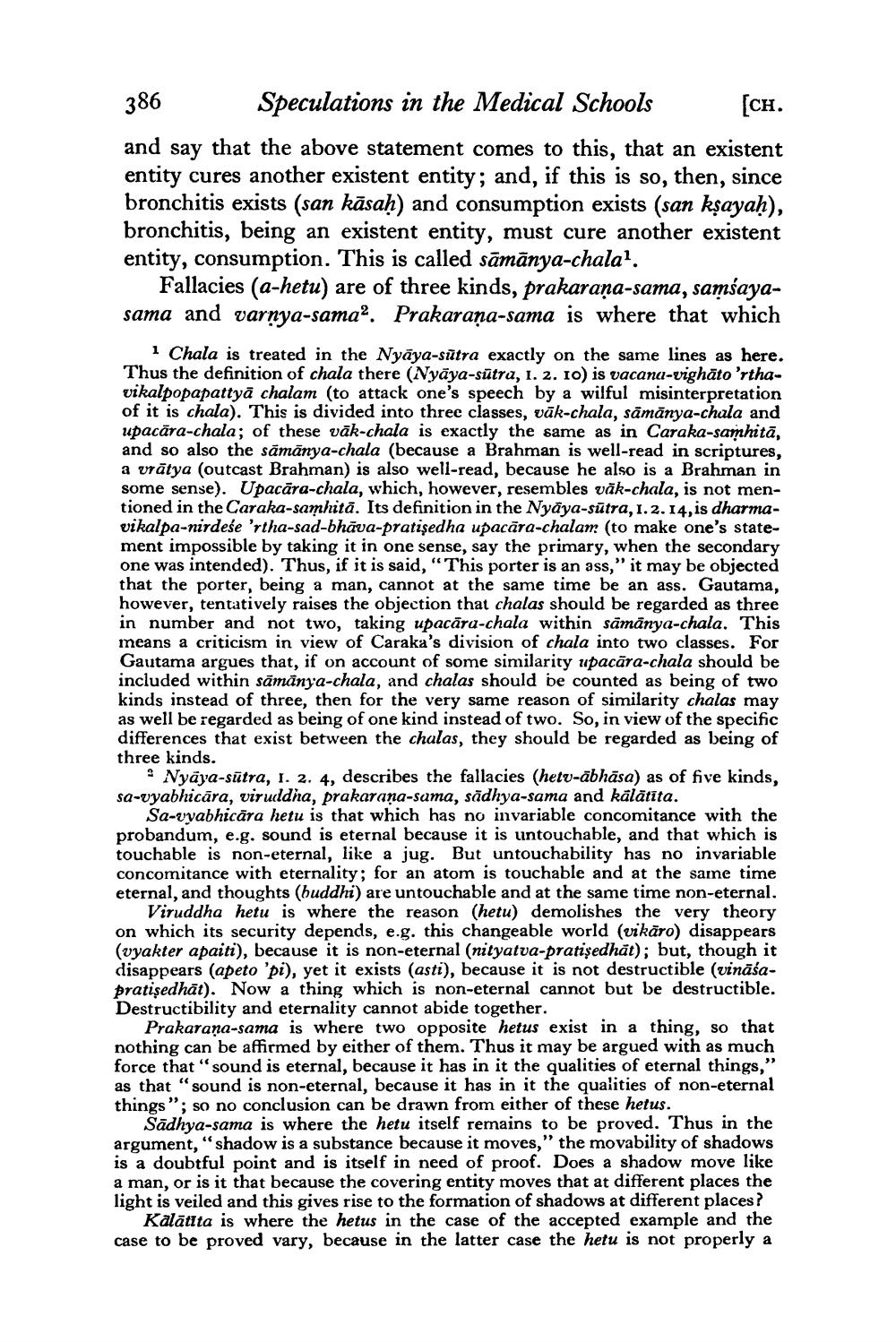________________
386
Speculations in the Medical Schools
[CH.
and say that the above statement comes to this, that an existent entity cures another existent entity; and, if this is so, then, since bronchitis exists (san kāsaḥ) and consumption exists (san kṣayaḥ), bronchitis, being an existent entity, must cure another existent entity, consumption. This is called sāmānya-chala1.
Fallacies (a-hetu) are of three kinds, prakaraṇa-sama, samsayasama and varnya-sama2. Prakaraṇa-sama is where that which
1 Chala is treated in the Nyaya-sutra exactly on the same lines as here. Thus the definition of chala there (Nyaya-sutra, 1. 2. 10) is vacana-vighato'rthavikalpopapattya chalam (to attack one's speech by a wilful misinterpretation of it is chala). This is divided into three classes, vāk-chala, sāmānya-chala and upacara-chala; of these vak-chala is exactly the same as in Caraka-samhita, and so also the samanya-chala (because a Brahman is well-read in scriptures, a vratya (outcast Brahman) is also well-read, because he also is a Brahman in some sense). Upacara-chala, which, however, resembles vāk-chala, is not mentioned in the Caraka-samhita. Its definition in the Nyaya-sutra, 1.2. 14, is dharmavikalpa-nirdese 'rtha-sad-bhava-pratiṣedha upacāra-chalam (to make one's statement impossible by taking it in one sense, say the primary, when the secondary one was intended). Thus, if it is said, "This porter is an ass," it may be objected that the porter, being a man, cannot at the same time be an ass. Gautama, however, tentatively raises the objection that chalas should be regarded as three in number and not two, taking upacara-chala within samanya-chala. This means a criticism in view of Caraka's division of chala into two classes. For Gautama argues that, if on account of some similarity upacara-chala should be included within samanya-chala, and chalas should be counted as being of two kinds instead of three, then for the very same reason of similarity chalas may as well be regarded as being of one kind instead of two. So, in view of the specific differences that exist between the chalas, they should be regarded as being of three kinds.
Nyaya-sutra, I. 2. 4, describes the fallacies (hetv-abhāsa) as of five kinds, sa-vyabhicāra, viruddha, prakarana-sama, sadhya-sama and kālātīta.
Sa-vyabhicara hetu is that which has no invariable concomitance with the probandum, e.g. sound is eternal because it is untouchable, and that which is touchable is non-eternal, like a jug. But untouchability has no invariable concomitance with eternality; for an atom is touchable and at the same time eternal, and thoughts (buddhi) are untouchable and at the same time non-eternal.
Viruddha hetu is where the reason (hetu) demolishes the very theory on which its security depends, e.g. this changeable world (vikāro) disappears (vyakter apaiti), because it is non-eternal (nityatva-pratiṣedhat); but, though it disappears (apeto 'pi), yet it exists (asti), because it is not destructible (vināśapratisedhat). Now a thing which is non-eternal cannot but be destructible. Destructibility and eternality cannot abide together.
Prakaraṇa-sama is where two opposite hetus exist in a thing, so that nothing can be affirmed by either of them. Thus it may be argued with as much force that "sound is eternal, because it has in it the qualities of eternal things,' as that "sound is non-eternal, because it has in it the qualities of non-eternal things"; so no conclusion can be drawn from either of these hetus.
Sadhya-sama is where the hetu itself remains to be proved. Thus in the argument, "shadow is a substance because it moves," the movability of shadows is a doubtful point and is itself in need of proof. Does a shadow move like a man, or is it that because the covering entity moves that at different places the light is veiled and this gives rise to the formation of shadows at different places? Kalatita is where the hetus in the case of the accepted example and the case to be proved vary, because in the latter case the hetu is not properly a




